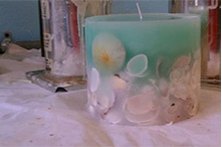Stages of Photosynthesis of a Flower
Photosynthesis is a process in which flowers and other plants combine energy from sunlight with carbon dioxide and water to produce glucose and oxygen. Glucose is a building block for more complex sugars and starches, which can serve as energy reserves or form proteins for plant growth and development.
-
Collecting Carbon Dioxide and Water
-
Plants obtain carbon dioxide through stomata, which are small openings located on the leaves and surrounded by two guard cells that can open or close. Water enters the plants by osmosis through the root hairs. Specialized xylem cells carry the water up to the leaves along the transpiration stream. The stomata close at night to prevent excess water loss by transpiration. (Since photosynthesis doesn't occur in the absence of sunlight, stomata don't need to collect carbon dioxide at night.)
Light Reactions
-
The light-dependent reactions of photosythesis provide energy for the light-independent reactions. In the light reactions, plants absorb light energy by means of a pigment called chlorophyll. They then use the energy from excited electrons in chlorophyll molecules to break down water in a photolysis reaction. In addition, the excited electrons produce ATP (adenosine triphosphate), in a process called photophosphorylation. In the final stage of the light-dependent reactions, excited electrons from chlorophyll molecules, and protons derived from the photolysis reaction, reduce nicotinamide adenine dinucleotide phosphate (NADP), forming reduced NADP, which is necessary for the light-independent reactions.
-
Light-Independent Reactions
-
In this stage of photosynthesis, ATP and reduced NADP derived from the light-dependent reactions reduce carbon dioxide molecules, and link them together to make carbohydrates such as glucose. In addition to providing a source of energy, the carbohydrates produced during photosynthesis can produce other organic molecules such as fats and proteins, which are essential for plant growth and repair.
-
References
- Photo Credit flower image by martini from Fotolia.com



















